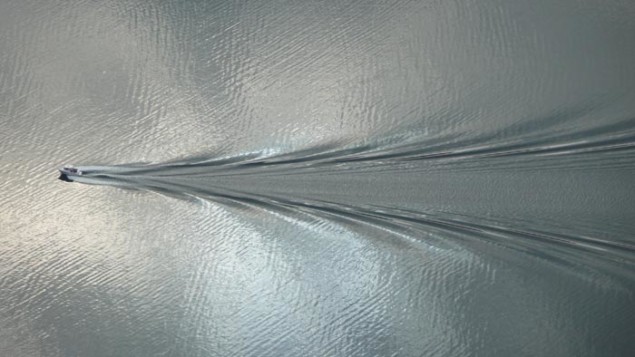
Lord Kelvin may have been an accomplished sailor, but he might have missed a trick when he famously described the phenomenon of wakes fanning out at a constant angle of 19.47°, no matter the speed of the vessel. That is the claim of two French physicists, who have used satellite images and mathematical modelling to study narrower wakes associated with fast-moving boats.
Kelvin’s prediction is rooted in two key properties of gravity waves on the water surface: first, that those with large wavelengths travel faster than those with short wavelengths; and second, that the group velocity of a deep-water wave is exactly half its phase velocity. As a boat moves through calm water, it excites waves over a range of wavelengths, with the longest speeding away faster than the shortest and then dissipating. Constructive interference between the slower, shorter waves causes a pair of shock waves to form in a distinctive V-shape that emanates from the boat.
Kelvin showed that the angle that each arm of the V makes with the centre line is 19.47°, irrespective of how fast the boat is travelling. It is a universal pattern that even holds true for a duck traversing a pond.
But when Marc Rabaud of University of Paris-Sud in Orsay tried to demonstrate the phenomenon to a group of physics teachers at a local pool, he was stumped as to why his set-up produced much narrower wakes. A decade later, still puzzled, Rabaud and colleague Frédéric Moisy noticed that the photographs they used to illustrate Kelvin wakes to fluid-mechanics students were at odds with the theory they were trying to teach.
Kelvin or Mach angle?
Narrow wakes had been spotted before, of course, but scholars had come up with various ways of rationalizing their existence: the effects of shallow waters; superposing wave patterns; turbulence; and nonlinear interactions, to name a few. “But if you look at the pictures that apparently don’t work – they’re actually the most interesting ones because they really tell you something new,” says Moisy. He and Rabaud analysed images from Google Earth, using measurements of boats’ hull lengths and wake angles, as well as calculations of their velocities, to help them build a new mathematical model to describe narrow wakes.
What the researchers found was that at higher speeds, boats produce a smaller spectrum of wavelengths that tends towards the length of the boat itself. According to the duo, a boat cannot produce wavelengths longer than its hull, so as soon as the wake hits a limiting speed governed by this length, its waves all travel with equal speed through the water, much like sound waves through air. At this point, like the Mach cone associated with supersonic jets, the angle of the wake is suddenly governed solely by the speed of the boat – the faster it goes, the more its wake stretches and narrows.
Rabaud and Moisy’s numerical simulations were in strong agreement with their image analyses, which together allowed them to identify a Froude number (a relation between boat velocity and hull length) of roughly 0.5 as the transition point between the Kelvin and Mach regimes.
Reservations raised
Others in the field are sceptical. Yuming Liu, a marine hydrodynamicist at the Massachusetts Institute of Technology, has several misgivings about the work, including the fact that the numerical simulations consider only the “near field” region directly behind the ship, rather than the whole area over a distance of several wavelengths, which he says biases the results. Not only that, he is troubled by the researchers’ argument that a ship cannot excite waves longer than the hull. “You just can’t make an assumption like that,” he cautions.
Tarmo Soomere, a mathematician and wave expert at Tallinn University of Technology, agrees, saying that “the devil here could be the assumption” and worries – along with Liu – that the model has overlooked finite-depth effects that are well known to have a strong effect on wake angle. Rabaud and Moisy concede that most of their images necessarily come from shallower waters within a kilometre of shore, since Google Earth‘s resolution drops off sharply away from land. Yet they rule out a depth effect on wake angle within their data. “If we plot our data as a function of water depth, there is just a scatter of points with no correlation at all,” says Moisy.
Soomere cautions that photographic images can be deceptive, highlighting the steepest but not necessarily the highest wave components. “A much simpler explanation of their results is that a vessel wake consists of several components of different nature, and you never know which one of these is actually visible in an image,” he explains. “I deeply believe that the researchers have found a simple model for one of these components though…and this is truly fascinating.”
The research is published in Physical Review Letters.



